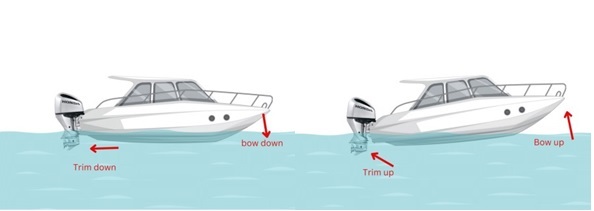How to trim an outboard motor

Outboard motor trim affects the ride, fuel economy, top end speed and even the safety of your boat. But knowing when to trim up or down can take a bit of practice. We have some tips on getting it right, but first let’s explain what trim is.
What is outboard motor trim?
Trim simply refers to the adjustment of the angle of your outboard motor against your boat, which in turn adjusts the angle of the prop shaft. This affects how the boat behaves in the water.
Your trim switch is on the control lever for ease of use while you’re operating the boat. Plus, you’ll also have a switch on the outboard itself to tilt the engine while you’re on land. These controls connect with hydraulic rams which directly adjust the angle of the outboard, within a range of around 20 degrees.
You can monitor the angle of your outboard via a gauge (either analogue or digital) on the dash.
How to get your trim right - If your trim gauge is at zero this means your propeller shaft is parallel to the water. Trimming the motor up will raise the bow of the boat but if you raise it too high that can lead to porpoising, where the boat bounces up and down as it travels.
Trimming the motor down beyond zero will cause the boat’s stern to lift thereby lowering the bow in the water. An easy way to think of trim is how it interacts with the bow: trim up = bow up, trim down = bow down.
Once you’re up the on the plane travelling in a straight line you can trim up until the boat is on the plane, running parallel to the water. When you reach optimal trim you’ll feel the steering get lighter, you’ll reach the desired RPM and you’ll see the wake will move towards the back of the boat.
However, when it comes to turning it’s a different story. You’ll need to trim down to ensure your propeller can ‘grip’ and help you turn safely.
Trim to the conditions and your load.
You should adjust your outboard trim according to the conditions you’re boating in. If you’re in choppy sea, it’s helpful for the boat to have more contact with the water with a lower bow which helps the boat slice through the waves. We recommend you trim your motor down in these conditions.
In contrast when you’re boating on a ‘millpond’ you’ll want less hull contact with the water to reach top end speed. That means trimming the engine up and raising the bow out of the water. Less contact with the water, means less drag and therefore better fuel efficiency too.
The load you have on board and how the weight is distributed will affect how the boat performs and in turn, how you should trim your motor.
Four signs your outboard trim isn’t right
If in doubt look out for these signs that your outboard trim isn’t quite right and might need some refining.
Poor boat handling – your boat is hard to steer and you don’t feel in full control
Porpoising – where the bow of your boat rises and falls even in smooth conditions
Slow acceleration – feeling sluggish and like the boat is dragging through the water
Lack of fuel efficiency – caused by excessive drag in the water
Too much spray – especially if it’s near the front of the boat
Of course there are other factors that can cause these performance issues, like engine height, but it’s worth adjusting the trim first to see if this remedies the issue.
Correct outboard motor trim takes practice to get right. When you become a seasoned pro, it will become second nature to make these small adjustments to improve your boat’s performance as you travel. But remember to factor in the conditions and your load too, as this will affect how you trim the motor.
For more tips and advice, get in touch with the GT Marine crew on 09 412 8348 or visit www.gtmarine.co.nz.